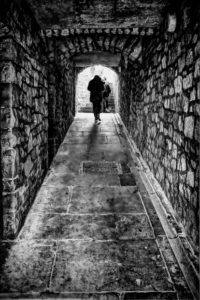Evocative Language and Mood
 Great writing is evocative. In her book, The Novelist’s Guide, Margaret Geraghty emphasises that evocative language builds expectation, tension, and establishes mood.
Great writing is evocative. In her book, The Novelist’s Guide, Margaret Geraghty emphasises that evocative language builds expectation, tension, and establishes mood.
Here is an example of mood building from Robert Ludlum’s The Parsifal Mosaic:
Evocative Writing.
‘The man in the dark overcoat and the dark-brimmed hat that shadowed his face climbed out of the two-toned coupe; with difficulty he avoid stepping into a wide puddle by the driver’s door. The sounds of the night rain were everywhere, pinging off the hood and splattering against the glass of the windshield, thumping the vinyl roof and erupting in the myriad pools that had formed throughout the deserted parking area on the banks of the Potomac river.’
This may at first appear to be a rather unexciting, scene-setting passage. Do we really care about the sound of rain? But upon closer examination the choice of words is informative.
The rain is ‘pinging’, ‘spattering’, ‘thumping’, ‘erupting’. These are explosive, evocative words. Rain is a symbol of the turmoil to come – it brings to mind the sound of bullets, the thudding of bodies. As readers we feel this subliminally and it raises our interest and expectation.
Evocative language is versatile. It helps create deeper levels of meaning and emotion that underpin the story. The writer sets up mood and expectation then expands it through action and plot.
In my novel Scarab, I try to create a sense of mystery and intrigue through words that evoke an otherworldly time and place beyond the confines of the underground chamber where the encounter between an archeologist and the mythical Sphinx occurs:
“The form broke free from the bright haze that enveloped it, as if encouraged by his request. It approached slowly, deliberately, feline-like, swaying a little from side to side, but drowsily, as if in a dream. Drake heard the sound of nail or claw, he knew not which, clicking along hard stone, growing louder and more distinct.
He could almost make it out now, but it was more of an intuition than a clear vision, like a shape glimpsed out of the corner of one’s eye by cells more sensitive to movement than to light—a shape which the mind had more to do in the making, than the eye in seeing.
It was indeed feline in movement and in appearance, like a giant cat, only larger and more graceful. Drake’s heart was bursting at the wonder of it. It seemed so close now, though distance was hard to judge. He reached out his hand, beckoning it forward. It hesitated a little, as if cautious of approaching the pleading man.”
In the above passage, words and phrases such as “drowsily”, “dream”, “shape”, “form” “broke free from the bright haze”, and “the sound of nail or claw”, help create just the right mood of mystery and anticipation the scene demands.
Summary
Use evocative language to create the appropriate mood for your scenes.
Tweet
The post Evocative Language and Mood appeared first on Stavros Halvatzis Ph.D..



